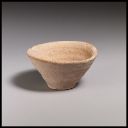An old shape with a new script
The shape of a drinking cup is related to its function. This is still true today: milk in a wine glass, cola in a coffee cup, or orange juice in a beer glass is seen as weird, perhaps voguish, or even inappropriate. This was also the case in ancient times; the shape of a cup or vase says something about its use.
This is the side view of this ancient clay cup. This egg-formed cup is called a footed goblet. The footed goblet appears for the first time in the mid-third millennium and is the earliest drinking cup found on Crete. This footed goblet shape remained popular for a long time, although the decorations varied, but disappeared in the mid-Middle Minoan period (MMIIa, ca. 1900-1800 BCE). At its peak, this footed goblet probably made up about 40% of all drinking vessels in Knossos, so it was probably used as a drinking vessel for everyday domestic or ceremonial use. Halfway through the Middle Minoan period, the function of this footed goblet is seemingly replaced by the one-handled cup and the conical cup. [Macdonald 2010, 106]. We do not know what the exact reason for this ceramic change was due to lack of archaeological sources, but it might indicate a change in domestic use or ceremonies that may be related to other, bigger changes in the Minoan period. Archeological sources show that palaces were destroyed and rebuilt on a larger scale and administrative sources indicate that the population increased and that the Minoan civilization expanded all over Crete.
What makes it very interesting is the dating of this particular footed goblet. It is dated after the decline and demise of the goblet-shaped cups, ca. 1700 BCE (in MMIIIa). Since this shape had hardly been used as a drinking vessel for one or two centuries by then, it seems to be a deliberate move to refer back to the ‘ancient times’ of the footed goblet. Another point of interest is its inscription: this archaic shape has been inscribed with Linear A writing, which was new at the time (from ca. 1800 BCE). We do not know whether this cup was inscribed immediately after being made, or that it was an archaic cup inscribed in later times when the Linear A script was emerging. However, since this archaic footed goblet form was no longer in use by then, it is plausible that the cup was used for special ceremonial occasions, in which the past was remembered in new, contemporary times. [Ibid, 208-209]
](https://micrio.thingsthattalk.net/uvAfS/views/max/193x128.jpg)
](https://micrio.thingsthattalk.net/yCNRz/views/max/221x128.jpg)
